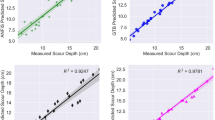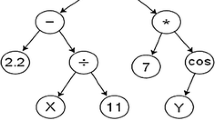Abstract
Baffled chutes are used in irrigation systems, storm water systems, wastewater canal chutes, river training, and drop structures for energy dissipation. Two flow regions occur on the flow surface of baffled chutes. These are black water and white water regions. Knowing the location of the inception point where white water begins to appear on the surface is important for determination of the non-aerated flow region. Thus, cavitation damage can be prevented. In this study, 160 laboratory test results have been used for determining black water length (i.e., length of the non-aerated region) of baffled chutes with stepped, wedge, trapezoidal, and T-shaped baffle blocks. The obtained observation data have been analyzed by well-known soft computing methods such as artificial neural networks (ANN), curve fitting (CF), non-linear regression (NLR) and special extreme learning machine (ELM). The methods’ performance in mapping input data to the output were compared. The mean regression errors calculated by the curve fitting model, ANN, NLR and ELM are obtained as 2.5, 8.0, 11.25 and 0.8 %, respectively. The experimental results show that ELM’s nonlinear system modeling capability is superior to ANN, NLR, and CF.







Similar content being viewed by others
References
Alcin OF, Sengur A, Ghofrani S, Ince MC (2014) GA-SELM: greedy algorithms for sparse extreme learning machine. Measurement 55:126–132
Alcin OF, Sengur A, Ince MC (2015) Forward–backward pursuit based sparse extreme learning machine. J Fac Eng Archit Gazi Univ 30(1):111–117
Azmathullah H, Deo M, Deolalikar P (2005) Neural networks for estimation of scour downstream of a ski-jump bucket. J Hydraul Eng (ASCE) 131(10):898–908
Azmathullah HMD, Deo MC, Deolalikar PB (2006) Estimation of scour below spillways using neural networks. J Hydraul Res 44(1):61–69
Bilhan O, Emiroglu ME, Kisi O (2010) Application of two different neural network techniques to lateral outflow over rectangular side weirs located on a straight channel. Adv Eng Softw 41(6):831–837
Boes RM, Hager WH (2003) Two-phase flow characteristics of stepped spillways. J Hydraul Eng (ASCE) 129(9):661–670
Chang LC, Chang FJ (2001) Intelligent control for modelling of real-time reservoir operation. Hydrol Process 15:1621–1634
Chang YT, Chang LC, Chang FJ (2005) Intelligent control for modelling of real-time reservoir operation. Part II: ANN with operating curves. Hydrol Process 19:1431–1444
Chanson H (1994) Comparison of energy dissipation between nappe and skimming flow regimes on stepped chutes. J Hydraul Res 32(2):213–218
Emiroglu ME, Kisi O, Bilhan O (2010) Predicting discharge capacity of triangular labyrinth side weir located on a straight channel by using an adaptive neuro-fuzzy technique. Adv Eng Softw 41(2):154–160
Hagan MT, Menhaj MB (1994) Training feed forward networks with the Marquaradt algorithm. IEEE Trans Neural Netw 6:861–867
Hanbay D, Baylar A, Ozpolat E (2009) Predicting flow conditions over stepped chutes based on ANFIS. Soft Comput 13(7):701–707
Haykin S (1998) Neural networks—a comprehensive foundation, 2nd edn. Prentice-Hall, Upper Saddle River, pp 26–32
Huang GB, Zhu QY, Siew CK (2006) Extreme learning machine: theory and applications. Neurocomputing 70(1):489–501
Karunanithi N, Grenney WJ, Whitley D, Bovee K (1994) Neural networks for river flow prediction. ASCE J Comp Civil Eng 8(2):201–220
Kaya N, Emiroglu ME (2010) Study of oxygen transfer efficiency at baffled chutes. Proc Inst Civil Eng Water Manag 13(9):447–456
Khatsuria RM (2005) Hydraulics of spillways and energy dissipators. Marcel Dekker, New York
Lawrence S, Back AD, Tsoi AC, Giles CL (1997) On the distribution of performance from multiple neural network trials. IEEE Trans Neural Netw 8(6):1507–1517
Mantas CJ (2008) A generic fuzzy aggregation operator: rules extraction from and insertion into artificial neural networks. Soft Comput 5(12):493–514
Marquardt DW (1963) An algorithm for least-squares estimation of nonlinear parameters. J Soc Ind Appl Math 11(2):431–441
Noori R, Hooshyaripor F (2014) Effective prediction of scour downstream of ski-jump buckets using artificial neural networks. Water Resour Regime Water Bodies 41(1):8–18
Noori R, Khakpour A, Omidvar B, Farokhnia A (2010) Comparison of ANN and principal component analysis-multivariate linear regression models for predicting the river flow based on developed discrepancy ratio statistic. Expert Syst Appl 37:5856–5862
Noori R, Karbassi AR, Mehdizadeh H, Vesali-Naseh M, Sabahi MS (2011) A framework development for predicting the longitudinal dispersion coefficient in natural streams using an artificial neural network. Environ Prog Sustain Energy 30:439–449
Noori R, Deng Z, Kiaghadi A, Kachoosangi F (2016) How reliable are ANN, ANFIS, and SVM techniques for predicting longitudinal dispersion coefficient in natural rivers? J Hydraul Eng 04015039. doi:10.1061/(ASCE)HY.1943-7900.0001062
Oh C, Yu C, Cheong Y, Yim G, Song H, Hong J, Ji S (2015) Efficiency assessment of cascade aerator in a passive treatment system for Fe(II) oxidation in ferruginous mine drainage of net alkaline. Environ Earth Sci 73:5363–5373
Peterka AJ (1984) Hydraulic design of stilling basins and energy dissipators. United States Department of the Interior Bureau of Reclamation, USA. In: A water resources technical publication, engineering monograph, No. 25. Denver, Colorado
Spline Interpolation (2013) http://en.wikipedia.org/wiki/Spline_interpolation. Accessed 23 May 2013
Talu MF, Gül M, Alpaslan N, Yigitcan B (2013) Calculation of melatonin and resveratrol effects on steatosis hepatis using soft computing methods. Comput Methods Programs Biomed 111(2):498–506
Yang H-C, Chang F-J (2005) Modelling combined open channel flow by artificial neural networks. Hydrol Process 19:3747–3762
Zare H, Doering J (2012) Inception point of air entrainment and training wall characteristics of baffles and sills on stepped spillways. J Hydraul Eng 138(12):1119–1124
Acknowledgments
The authors wish to thank Professor M. Emin Emiroglu of the Firat University for their suggestions and assistance.
Author information
Authors and Affiliations
Corresponding author
Rights and permissions
About this article
Cite this article
Dursun, O.F., Talu, M.F., Kaya, N. et al. Length prediction of non-aerated region flow at baffled chutes using intelligent nonlinear regression methods. Environ Earth Sci 75, 680 (2016). https://doi.org/10.1007/s12665-016-5486-8
Received:
Accepted:
Published:
DOI: https://doi.org/10.1007/s12665-016-5486-8




